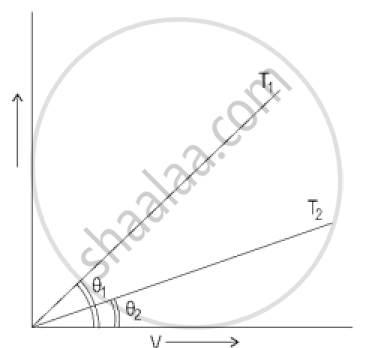Advertisements
Advertisements
प्रश्न
An alternating current is given by i = i1 cos ωt + i2 sin ωt. The rms current is given by
पर्याय
`(l_1 +l_2)/sqrt2`
`|i_1 + i_2|/sqrt2`
`sqrt(i_1^2 + i_2^2)/2`
`sqrt(i_1^2+i_2^2)/sqrt2`
उत्तर
`sqrt(i_1^2 + i_2^2)/2`
Given:
i = i1 cos ωt + i2 sin ωt
The rms value of current is given by,
`i_{rms} = sqrt(\[\int_0^T i^2 dt]/\[\int_0^T dt`
`i = i_1 cos ωt + i_2 sin omegat`
`i_{rms} = sqrt(\[\int_0^T(i_1 cos omegat + i_2 sin omegat)^2 dt)/(\int_0^T dt)`
`i_rms = sqrt(\[\int_0^T (i_1^2 cos^2 omegat + i_2^2 sin^2 omegat + 2i_1 i_2 sin omegat cos omegat) dt)/\int_0^T)`
`i_{rms} = sqrt(\[\int_0^T (i_1^2 ((cos 2omegat + 1))/2+ i_2^2((1-cos 2omegat))/2 + i_1i_2 sin 2omegat) dt )/[\int_0^T dt`
`[therefore cos^2 omegat = ((cos 2omegat + 1))/2 , sin^2 omegat = ((1 - cos 2omegat))/2 ]`
We know that, T = 2π
Integrating the above expression
\[i_{rms} = \sqrt\frac{{\frac{1}{2} i_1^2\left(\int_0^{2\pi} 1dt + \int_0^{2\pi} cos 2\omega t\ dt\right) + i_2^2\left( \int_0^{2\pi} 1 dt - \int_0^{2\pi} cos 2 \omega t\ dt\right) + i_1 i_2 \int_0^{2\pi} sin 2 \omega t\ dt }}{\int_0^{2\pi} dt} \]
The following integrals become zero
\[\int_0^{2\pi} cos 2 \omega t \ dt = 0 = \int_0^{2\pi} sin2 \omega t\]
Therefore, it becomes
\[i_{rms} = \sqrt\frac{{\frac{i_1^2}{2} \left(\int_0^{2\pi} 1dt\right) + \frac{i_2^2}{2}\left(\int_0^{2\pi}1dt\right)}}{\int_0^{2\pi} dt}\]
`i_rms = sqrt((i_1^2/2 xx 2pi + (i_2^2)/2 xx 2pi)/(2pi)`
`⇒i_rms = sqrt((i_1^2) +(i_2^2))/2`
APPEARS IN
संबंधित प्रश्न
A device X is connected across an ac source of voltage V = V0 sin ωt. The current through X is given as
`I = I_0 sin (omega t + pi/2 )`
1) Identify the device X and write the expression for its reactance.
2) Draw graphs showing the variation of voltage and current with time over one cycle of ac, for X.
3) How does the reactance of the device X vary with the frequency of the ac? Show this variation graphically.
4) Draw the phasor diagram for the device X.
In a series LCR circuit connected to an ac source of variable frequency and voltage ν = vm sin ωt, draw a plot showing the variation of current (I) with angular frequency (ω) for two different values of resistance R1 and R2 (R1 > R2). Write the condition under which the phenomenon of resonance occurs. For which value of the resistance out of the two curves, a sharper resonance is produced? Define Q-factor of the circuit and give its significance.
Can a hot-wire ammeter be used to measure a direct current of constant value? Do we have to change the graduations?
An alternating current of peak value 14 A is used to heat a metal wire. To produce the same heating effect, a constant current i can be used, where i is
A constant current of 2.8 A exists in a resistor. The rms current is
Find the time required for a 50 Hz alternating current to change its value from zero to the rms value.
The household supply of electricity is at 220 V (rms value) and 50 Hz. Find the peak voltage and the least possible time in which the voltage can change from the rms value to zero.
An electric bulb is designed to operate at 12 volts DC. If this bulb is connected to an AC source and gives normal brightness, what would be the peak voltage of the source?
The peak power consumed by a resistive coil, when connected to an AC source, is 80 W. Find the energy consumed by the coil in 100 seconds, which is many times larger than the time period of the source.
A capacitor of capacitance 10 μF is connected to an oscillator with output voltage ε = (10 V) sin ωt. Find the peak currents in the circuit for ω = 10 s−1, 100 s−1, 500 s−1 and 1000 s−1.
Answer the following question.
A small town with a demand of 1200 kW of electric power at 220 V is situated 20 km away from an electric plant generating power at 440 V. The resistance of the two wirelines carrying power is 0.5 Ω per km. The town gets the power from the line through a 4000-220 V step-down transformer at a sub-station in the town. Estimate the line power loss in the form of heat.
A small town with a demand of 800 kW of electric power at 220 V is situated 15 km away from an electric plant generating power at 440 V. The resistance of the two wire line carrying power is 0.5 Ω per km. The town gets power from the line through a 4000-220 V step-down transformer at a sub-station in the town.
(a) Estimate the line power loss in the form of heat.
(b) How much power must the plant supply, assuming there is negligible power loss due to leakage?
(c) Characterise the step up transformer at the plant.
If `|vec"A" xx vec"B"| = sqrt3 vec"A" . vec"B"` then the value of is `|vec"A" xx vec"B"|` is
The period of oscillation of a simple pendulum is T = `2π sqrt"L"/"g"`. The measured value of L is 20.0 cm known to have 1 mm accuracy and the time for 100 oscillations of the pendulum is found to be 90 s using a wristwatch of ls resolution. The accuracy in the determination of g is:
In a transformer Np = 500, Ns = 5000. Input voltage is 20 volt and frequency is 50 HZ. Then in the output, we have,
When a voltage measuring device is connected to AC mains, the meter shows the steady input voltage of 220V. This means ______.
In the Figure below, the current-voltage graphs for a conductor are given at two different temperatures, T1 and T2.

- At which temperature T1 or T2 is the resistance higher?
- Which temperature (T1 or T2) is higher?
